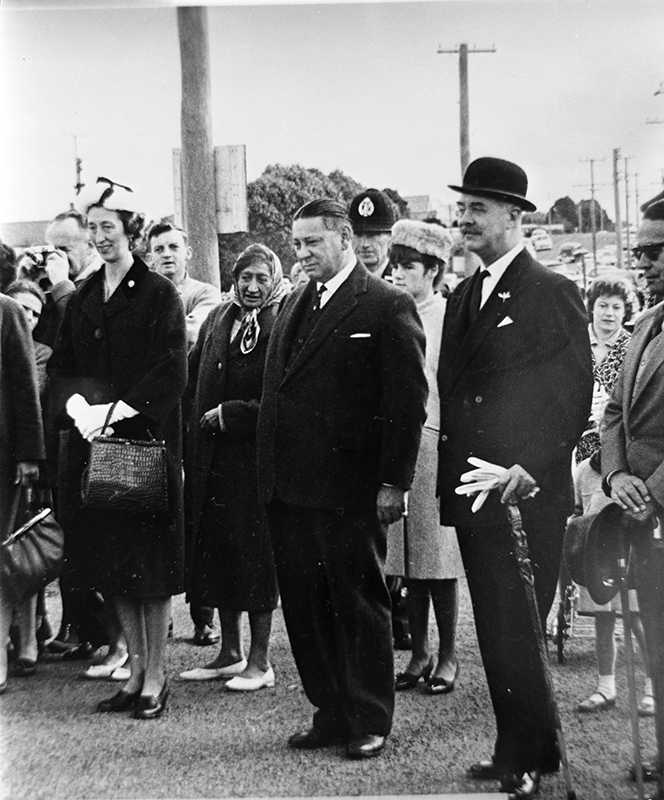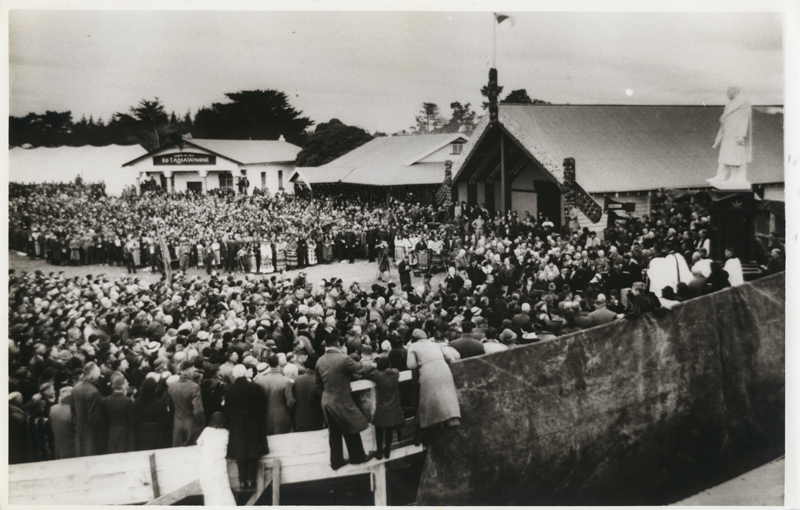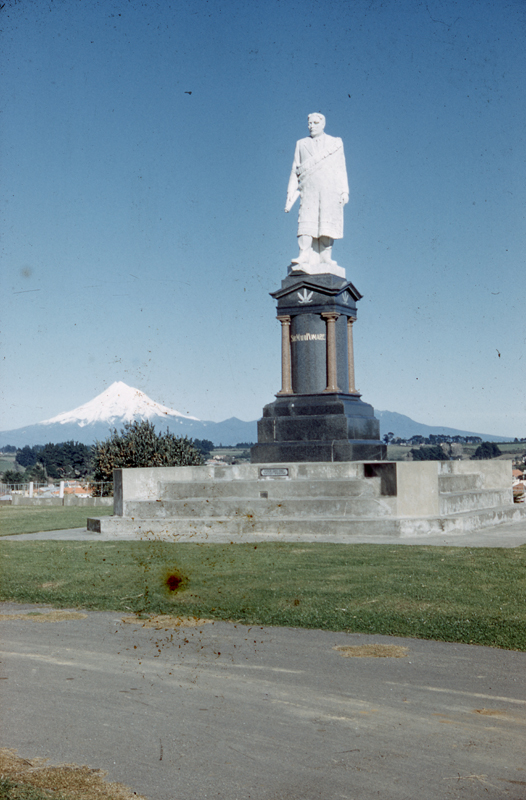


When Parihaka was invaded on 5 November 1881, a five-year-old boy lost his toe. That youngster grew up to be Sir Māui Pōmare, New Zealand's first Māori doctor and the Minister of Health. His great-granddaughter, Miria Pōmare, talks about his remarkable life.
Although Miria was born many years after his death in 1930, she is the holder of Sir Māui's story. Her own father, known as Young Māui, was given the name of his grandfather, and became the family historian. When he died in 1995, Miria and her younger brother, Te Rakaherea, became the guardians of Sir Māui's writings, his taonga and even his mana.
Miria and her mother Louise live in a cottage on Hongoeka Marae in Plimmerton. All around the immaculate house are Sir Māui's treasures, including carvings, paintings and fine china. On the kitchen wall hang tiny teacups collected on his overseas travels.
Relaxed, Miria sits on a comfortable couch strewn with covers and cushions. Young Māui looking over her from a colour photograph on the wall above. As she talks, Miria turns from reluctant speaker to eloquent orator, the life of her great-grandfather pouring from her like practiced prayers.
Sir Māui was the oldest of four children, and spent his early days in Taranaki. "He was present with his parents at Parihaka when it was ransacked in 1881. He was one of the children welcoming the troops and offering them bread," she says. "He lost a toe - it was stomped on by one of the horses."
Even though Sir Māui was just five years old, the events at Parihaka and his memories of non-violent leader Te Whiti-o-Rongomai left indelible imprints in his mind. "Which shaped the direction of his life, really," Miria says. He was also driven by Wiremu Pōmare's last words. "His father, on his deathbed, said to Māui, 'go forth into the world and seek the wisdom of the Pākehā knowledge'," she says.
"The inference was that the answers to the cure of the ills confronting Māoridom at the time were embedded in Pākehā knowledge because the problems inflicted on Māori since the 1840s were introduced by the Pākehā." Miria says that nearing the end of the 1800s, the Māori race was beginning to die out because of diseases brought to New Zealand by European settlers. Alienation from land was also having detrimental effects.
The deathbed request from his father, led Sir Māui to medicine. "There were a lot of his elders and kaumatua who encouraged him to study law, but he felt that he could be better use as a doctor. He probably thought 'What's the use of getting the land back if there's no one to tend it'."
Sir Māui attended schools at Waitara and the Chathams, St Stephen's Native Boys' School, and the Church of England Grammar School in Parnell, Auckland. He also went to Christchurch Boys' High School. When his mother, Mere, died in 1889, the youngster's aunt, Heni Te Rau Nicoll, became his guardian and transferred him to Te Aute College in the Hawke's Bay.
His aunt was a Seventh Day Adventist and through her church Sir Māui was given the chance to study medicine at Battle Creek College in Michigan. "Before he left for America, he was taken under the wing of a tohunga from Taranaki and he was taken to the foot of the mountain and educated in the ancient ways of his people," Miria says. "So, he left with a strong sense of who he was and where he belonged. He always intended to come back. This was a mission for him to search out this knowledge and bring it back to assist his people."
America proved an incredible adventure for this young man. To pay for his studies and living needs, he worked in kitchens and went on the public speaking circuit talking about Māori culture. "He had to be very resourceful, witty, funny and entertaining," she says. "People were very interested in this guy, because he had an olive complexion - they referred to him as a Māori prince."
Like his athletic grandmother, Sir Māui was also a fine sportsman. In America, his speciality was tennis. "He won the equivalent of what would now be known as the US Open," Miria says. "That was quite a feat for a Māori boy from the sticks." Especially, since he managed to win amidst studying hard to become a doctor.
He also met amazing people, including a man called Peabody. Although it's unclear exactly who this Peabody was, it's likely he was a distant relation of the famous American philanthropist who founded the Peabody Institute.
The medical student came upon an accident in a city street where he found the man, a wealthy entrepreneur, impaled by the shaft that joined his trap and horse. "As a result, Peabody made him his medical adviser; part of that role included accompanying him overseas."
One of those trips was to Venice, where an assailant attempted to stab the American businessman. "Sir Māui had a very special whalebone walking stick given to him by his Ngāti Mutunga relations to keep him safe," Miria says. The stick was inlaid with pāua. Miria says her great-grandfather was trained to fight with a taiaha (spear), so when the attacker advanced, Sir Māui reacted instinctively. "He was able to knock the knife out of the hand of the assailant and he hit him on the head with the stick, and then they just ran ... they never knew whether the assailant woke again. But he saved Peabody's life again. There's a bit of pāua shell missing from the stick and the story goes that it became embedded in the head of the would-be assailant."
Through his association with Peabody, Sir Māui was introduced to movers and shakers of the day, including US president Theodore Roosevelt. Miria says her grandfather advised him on medical matters.
He also knew Will Keith Kellogg of cornflake fame. Sir Māui was studying at Battle Creek in 1894, the same year and place Kellogg developed the well-known breakfast cereal. "There is a family story that he (Sir Māui) had a hand in developing the cornflake," Miria says. "He probably just tasted it!"
After completing his studies at Battle Creek, Sir Māui went to the American Medical Missionary College in Chicago to complete his degree. In 1899, the Taranaki-born man graduated from the Chicago college, becoming New Zealand's first Māori doctor.
Another Taranaki son, Sir Peter Buck (Te Rangi Hīroa), was the first Māori doctor to graduate from a New Zealand university. He gained his medical degree from Otago University in 1904.
In 1900, Sir Māui returned to Aotearoa. In March 1901, he began working as a Māori health officer. This was not a job he took on lightly, as is revealed in his first annual report: "It was with a heart full of fear and trembling that my mission was undertaken. Fear and trembling did I say? Yes, for the deeply rooted superstition of ages - the strongholds of tohungaism, the binding law of tapu, the habits and practices of centuries, the mistrust of the Pākehā - these were the Goliaths in the way of sanitary progress among the Māori."
Miria explains what her great-grandfather and the Māori people of that time faced in terms of disease and changed lifestyles. Prior to European settlement and the confiscation of land, iwi lived on hill-placed pā sites. These had good drainage, especially in regards to effluent - polluted waters flowed away from living areas. With land alienation, Māori were forced to live on flat land, closer together and without proper sanitation. Often they were drinking polluted water, which spread disease.
"Trying to convince the people not to drink the water before boiling it first, or sieving it, was very unpopular," Miria says. "There were many instances where he was ridiculed and thrown off marae and not welcomed because he was promoting these very unpopular measures." In one instance, he won the people over through science. Māui was on a marae talking about sanitising water when he was verbally attacked. "They accused him of being brainwashed by the Pākehā way of thinking and he was about to be thrown off the marae when he pleaded with them to bring him a bucket of water, and he pulled out his microscope and got them to have a look at what they were drinking," Miria says. "They were horrified at these little bully-headed bugs that were just prevalent in the water they were drinking. He was then able to show them that they had to boil the water - and that turned them around," she says.
"He lived his whole life in service to his people, although he was much-maligned and misunderstood. He was before his time."
As health officer, Sir Māui regularly visited Māori villages, often travelling miles on foot to inspect the water supply, rubbish disposal and sanitary arrangements. He was also worried about the health risks of rotting, derelict whare, which became breeding grounds for rats and vermin. Because of tapu laws, most villages contained these buildings. In three years, Sir Māui burnt 1900 of them.
During his journeys, the Māori health officer often passed Wairakaea Station on the east coast of the North Island. There, he met his future wife, Mildred Amelia (Miria) Tapapa Woodbine Johnson, the daughter of a wealthy orchardist and his well-educated Māori wife.
Sir Māui and Miria were married in January 1903, and moved to Lower Hutt. Their combined resources enabled them to build a gracious home, Hiwiroa, on seven acres of land with tennis courts and elaborate gardens. The couple entertained visitors and Miria was a fine hostess, who helped her husband with his political dreams.
One of his aims was to outlaw ‘charlatan tohungaism’. Young Miria, who was named after her great-grandmother, says Sir Māui wasn't against the tohunga of old, who practiced in the best interests of Māori and cared for their spiritual needs. But in the early days of the 1900s, some ‘fakes’ were attempting to heal people by dunking them in cold water or prescribing alcohol as a cure all. Miria says some of these ‘healers’ were Māori who had learnt the alternative value system of Pākehā and decided to make money out of the sick.
"He detested this practice of charlatan tohungaism and believed it was responsible for the continued deaths of Māori people and had to be stamped out," Miria says. The charlatans also took no responsibility for the consequences. When a sick person died, the tohunga would blame it on the patient, saying they had breached tapu or had committed a spiritual transgression. If a person died after being looked after by a medical doctor, it was said that they had died at the hands of a Pākehā medicine man.
In 1904, Sir Māui (known then as Dr Pōmare) wrote this in his annual report: "I cannot be emphatic enough in condemning these tohunga for I have seen the result of their work. In one pā alone, 17 of what might have been considered the hope and pride of the tribe were, I consider, cruelly murdered by the wanton practices of a tohunga in whom many natives have faith; I do not think a single one of the 17 children who were sacrificed need have died for they were only ill with measles."
Three years later, the Tohunga Suppression Act of 1907 was passed through Parliament. "This was not about his personal vendetta or disloyalty towards Māoridom," Miria says. "He was very proud of who he was. It was actually about preserving the well-being of his people; it was about public health."
Miria says Taranaki was the main stronghold of resistance to new health measures. "The problem was Te Whiti and Tohu. They were trying to hang on to the inclement ways of their people in the face of Pākehā."
Despite often being at odds, Miria says her great-grandfather held Te Whiti, the pacifist leader of Parihaka, in high esteem. "There were clashes later on over public health issues, but there was never a question of loyalty," Miria says.
When Te Whiti died on November 18, 1907, Sir Māui, as Te Atiawa chief, spoke at his tangi.
At the end of 1911, Sir Māui was elected to Parliament as the independent member for Western Māori. He became a Cabinet member of William Massey's Government, a Member of the Executive Council representing the Native Race, and also became the Minister in charge of Cook and other Islands.
In the Queen's Birthday Honours List of 1922, he was created a Knight Commander of the British Empire. From then on he was known as Sir Māui Pōmare. The following year, he became the Minister of Health.
Over the years, he had many dealings with another Taranaki-born health crusader, Sir Truby King. It was not unknown for the Plunket founder to phone Sir Māui in the middle of the night to continue a conversation they had started a few days before.
As Sir Māui progressed through life, he also kept in contact with medical colleagues and friends overseas. "He used them to bounce ideas off. They were fascinated with the situation here. They provided a lot of succour and support and the strength he needed to continue to work towards administering health to his people, often in the face of over-whelming opposition from his people," Miria says. "We have all that material and we will be compiling it in the next year or so."
Despite often clashing with Māori over issues of public health, Sir Māui kept fighting for his people. In the last years of his life, he moved his flagging energies from health to land.
"In fact, he started the treaty claims process by establishing the Commission of Inquiry into the confiscation of Taranaki lands in 1927," Miria says. The Taranaki Māori Trust Board rose out of that. They [the trust] still get a compensation payment every year from the Crown." He did this under the shadow of ill health. While many people thought Sir Māui had cancer, he had actually been battling tuberculosis for a number of years.
In 1930, he and Lady Pōmare went on a voyage to the United States. "When he went to America, he told everybody he was going on a health sojourn, but in fact he knew he was going to die there," Miria says. There was a reason for this end-of-life journey to the Glendale Sanitarium in Los Angeles. "It was necessary, because he wanted to be cremated. He knew that his people wouldn't carry out that wish because it's not customary within general Māori protocol to cremate the dead.
"He wanted to set an example to his people," she says, explaining how Sir Māui opposed having a body lying in state at a tangi for weeks on end. "The spread of contagious disease from the body was continuing to infect our people and it was killing them." So, when Sir Māui died on June 27, 1930, his body was cremated. "He had the last say," Miria nods.
Sir Māui's ashes were interred at the Ōwae Marae in Waitara. They lie beneath a Sicilian marble statue carved in his likeness. Alongside him in that tomb, are the ashes of his wife Miria and their two sons, Te Rakaherea and Naera.
Every year, Pōmare Day is held at the marae on the Sunday closest to the anniversary of his death. Te Ātiawa people use the weekend to celebrate Sir Māui's life and to discuss matters of importance to the iwi and people of Waitara.
Cody, J.F. (1953). Man of Two Worlds: Sir Māui Pōmare. Wellington: Reed.
Lange, R. (1999). May the people live: a history of Māori health development 1900-1920. Auckland: Auckland University Press.
Waitara, 1859-1936: a souvenir of Pōmare Memorial meeting, Manukorihi Pa, Waitara, June 27th 1936. (1936). New Plymouth: McLeod and Slade.
Puke Ariki Heritage Collection: Māui Pōmare
LinkPlease do not reproduce these images without permission from Puke Ariki.
Contact us for more information or you can order images online here.